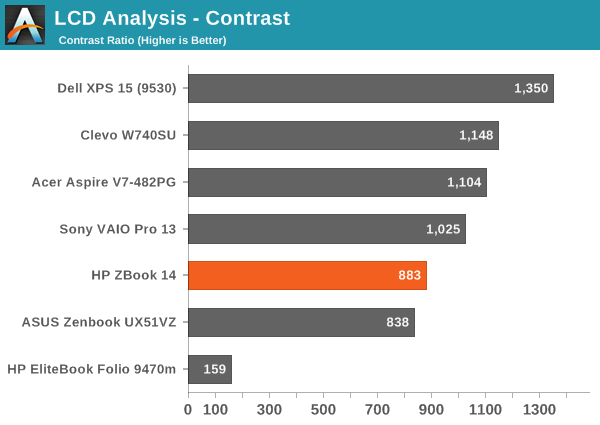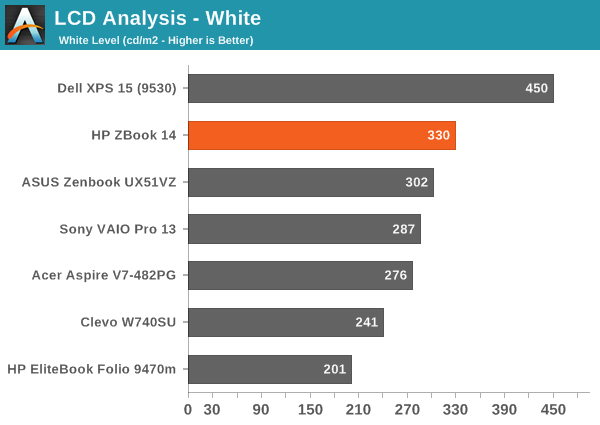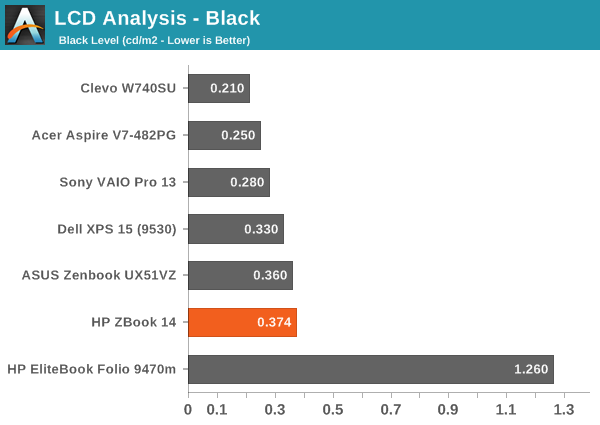HP ZBook 14 Review: Mobile Workstation Meets Ultrabook
by Jarred Walton on June 20, 2014 2:30 AM ESTHP ZBook 14: A Good LCD
It's worth noting up front that the display included on the unit we're testing is the 1080p IPS (UWVA) panel, with a matte finish. There's an option to get a touchscreen display, but it would be lower resolution (1600x900), glossy, and it would also make the unit thicker. Yeah, that's three strikes in my book. Anyway, the display is actually one of the best element of an already good design, and I'm always happy to see a good IPS (or similar technology) panel.
The colors ended up being some of the most accurate I've seen from a laptop – ever! What's more, even prior to calibration the colors are still quite good, so if you're not a stickler for perfect colors you could use the screen as-is and still be quite happy. As we're now focusing our testing on the out of box experience and haven't tested a lot of laptops with the new methodology, I won't include a bunch of LCD charts here, but you can view and compare scores in Notebook Bench. Let's start with the charts that haven't really changed, which focus on the contrast and brightness:



There's not much to report here; the display gets reasonably bright at 330 nits, and thanks to the matte coating it can still be used outdoors without too much trouble. The contrast is decent, particularly for a matte display, but we've seen a few better panels. At least we're not seeing anything like the poor panel used in the old Folio 9470m.
As you can see from the pre-calibration results, the display is really quite good at delivering the correct color. While we normally look for Delta E of 3.0 or less for something to be more or less unnoticed by the naked eye, for laptops I'd say even 4.0 is still acceptable. What's interesting with the ZBook 14 display is that the colors are all consistently around dE of 3-4. Normally we'll see a lot of colors below 2.0 and some spikes up to the high single digits – or even double digits. HP manages to keep nearly all of the colors below 5.0, and I think a couple shades of blue just barely break 6.0, but in general the results are good. Errors in shades of blue also tend to be the least visible to the human eye, so for most users the display will look quite accurate.
Post-calibration, the color accuracy is pretty much perfect. The grayscale results are all below 1.0, with the average being just 0.54; that's not entirely unheard of, but frequently when we see very good grayscale we'll still get a few colors that are off. That doesn't happen here, as the Color Checker chart is below 3.0 on all colors with an average of just 0.86, and the same holds for the saturations and gamut charts. Imaging professionals should be quite happy with this display; if they're not, I can't name another laptop that will deliver superior color accuracy. HP's DreamColor panels might deliver 10-bit color and a wider color gamut, but our past testing has shown them to still have a few issues with certain colors.


_thumb.jpg)
_thumb.jpg)
_thumb.jpg)
_thumb.jpg)
_thumb.jpg)
_thumb.png)
_thumb.png)
_thumb.png)
_thumb.png)
_thumb.png)
_thumb.png)
_thumb.png)
_thumb.png)
_thumb.png)
_thumb.png)








66 Comments
View All Comments
WeaponZero - Saturday, June 21, 2014 - link
I have this laptop for a few months already. The laptop is awesome but I wish it would stop BSOD every day or 2. I really hope HP fixes this issue as it is not acceptable for a 2k+ laptop.Side note, the laptop comes in 2 possible screen options AU Optronics panel or LG panel. Make sure you have the AU panel and the LG panel is worse. (still good but worse)
chribro - Thursday, July 31, 2014 - link
Do you know what % of the sRGB is covered with the AUO panel. The LG panel only covers 80% (according to the review on Notebookcheck).Any idea which panel this review has?
deontologist - Saturday, June 21, 2014 - link
Lol is Anandtech ever going to review the Surface 3?Dr.Neale - Saturday, June 21, 2014 - link
Jared, in the specs you list the dGPU as an M1400 instead of the M4100 cited throughout the article. Could you please fix this typo?JarredWalton - Monday, June 23, 2014 - link
Fixed, thanks!JFish222 - Tuesday, June 24, 2014 - link
Jared, it would be helpful to show images of the service panel. For a shop with IT personnel (or technically competent staff) on hand, this is indispensable.We've purchased a handful of these for the office.
We required
1) A high HD display
2) Light/ultrabook class 14"
3) Min. 5+hrs battery life running excel/word proc/internet
4) Ability to hit min 16GB of RAM
5) Ability to take punishment (you should see the dings one has received in its first week! Still runs great though!)
6) End user serviceability.
7) A myriad of ports (especially VGA without DVI adapter)
8) Docking station compatible with 2 DVI outs (an older Sony failed in this department.)
We originally had a couple of Lenovo X1 and X1 carbons floating around, and I've been an avid T series user myself.
Two things, however, made us move away from IBM:
- Soldering DIMMs to the motherboard, and limiting the ultra-book form factors to 12GB.
- To much work to service. Seriously.
We've already had two X1 batteries die right after the service contract was up (a 3rd went, but was still covered), and servicing those things was a nightmare. Between the screws and man hours . . . not worth the trouble.
And upgrades? The oldest X1 Carbon has 4GB of RAM. Great for the first few years, but while its CPU and SSD are quite serviceable, the RAM limitation became a major liability.
I can't begin to tell you how easy it is to service these HP's.
The docking station has been flawless, they look "professional" (staff members are VERY picky and refused to use Dell).
I'm in a difficult environment where the applications are memory intensive (large excel models), the unit has to be durable, a jack of all trades, and easily serviceable. These fit the bill and I'm moving to standardize on these units.
I don't buy from HP directly, we're low volume and better deals can be had elsewhere. The upgraded screen is worth it. If you don't start with an SSD, I recommended you get one eventually. Fortunately these take standard height units as well as an additional M2